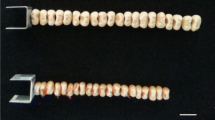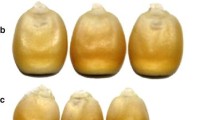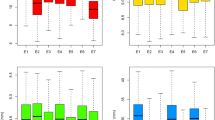Abstract
A dissection of the genetic regulation of protein, oil and starch contents in maize (Zea mays L.) kernels will enhance high-quality breeding. The objective of the present research was to detect the quantitative trait loci (QTL) controlling protein, oil, starch and lysine contents in maize kernels and to dissect their inheritable relationships and basis. A population of 498 recombinant inbred lines derived from a biparental cross of two elite inbred lines were grown in six environments. All individuals were genotyped with 151 pairs of simple sequence repeat markers to construct a genetic linkage map. Using composite interval mapping, we detected total 25, 13, 31 and 15 QTLs for protein, oil, starch and lysine contents, respectively, in six environments. 32 QTLs at bins 2.03–2.04, 2.05–2.07, 5.05–5.07, 6.01–6.04, 8.03–8.05 and 10.03–10.05 were stably expressed across multiple environments. Co-localizations of QTLs for the four traits were found on chromosomes 1, 2, 5, 6, 8, and 10. Part of the co-localized QTLs, the direction of QTL effects coincided with the sign of their phenotypic correlations, which likely indicates the presence of pleiotropic QTL or tight linkage among them. Additionally, seven pairs of QTLs with significant additive × additive epistatic interaction effects were identified based on single-environment QTL analysis. The results obtained from the present investigation may hold great promise for further studies of improving kernel quality in maize.

Similar content being viewed by others
References
Benitez J, Gernat A, Murillo J, Araba M (1999) The use of high oil corn in broiler diets. Poult Sci 78(6):861–865
Berke TG, Rocheford TR (1995) Quantitative trait loci for flowering, plant and ear height, and kernel traits in maize. Crop Sci 35(6):1542–1549
Bernardo R (2008) Molecular markers and selection for complex traits in plants: learning from the last 20 years. Crop Sci 48(5):1649
Blanc G, Charcosset A, Mangin B, Gallais A, Moreau L (2006) Connected populations for detecting quantitative trait loci and testing for epistasis: an application in maize. TAG Theor Appl Genet Theor Angew Genet 113(2):206–224
Boer MP, Wright D, Feng L, Podlich DW, Luo L, Cooper M, van Eeuwijk FA (2007) A mixed-model quantitative trait loci (QTL) analysis for multiple-environment trial data using environmental covariables for QTL-by-environment interactions, with an example in maize. Genetics 177(3):1801–1813
Champoux M, Wang G, Sarkarung S, Mackill D, O’Toole J, Huang N, McCouch S (1995) Locating genes associated with root morphology and drought avoidance in rice via linkage to molecular markers. Theor Appl Genet 90(7–8):969–981
Dudley J, Lambert R (2004) 100 generations of selection for oil and protein in corn. Plant Breed Rev 24(1):79–110
Dudley J, Lambert R, Alexander D (1974) Seventy generations of selection for oil and protein concentration in the maize kernel. Seventy generations of selection for oil and protein in maize CSSA, Madison, pp 181–212
Dudley J, Dijkhuizen A, Paul C, Coates S, Rocheford T (2004) Effects of random mating on marker–QTL associations in the cross of the Illinois high protein × Illinois low protein maize strains. Crop Sci 44(4):1419–1428
Dudley JW, Clark D, Rocheford TR, LeDeaux JR (2007) Genetic analysis of corn kernel chemical composition in the random mated 7 generation of the cross of generations 70 of IHP × ILP. Crop Sci 47(1):45
Goldman IL, Rocheford TR, Dudley JW (1994) Molecular markers associated with maize kernel oil concentration in an Illinois high protein × Illinois low protein cross. Crop Sci 34(4):908–915
Guo Y, Yang X, Chander S, Yan J, Zhang J, Song T, Li J (2013) Identification of unconditional and conditional QTL for oil, protein and starch content in maize. Crop J 1(1):34–42
Hopkins CG (1899) Improvement in the chemical composition of the corn kernel. J Am Chem Soc 21(11):1039–1057
Kosambi D (1943) The estimation of map distances from recombination values. Ann Eugen 12(1):172–175
Li Y, Wang Y, Wei M, Li X, Fu J (2009) QTL identification of grain protein concentration and its genetic correlation with starch concentration and grain weight using two populations in maize (Zea mays L.). J Genet 88(1):61–67
Lübberstedt T, Zein I, Andersen JR, Wenzel G, Krützfeldt B, Eder J, Ouzunova M, Chun S (2005) Development and application of functional markers in maize. Euphytica 146(1–2):101–108
Mangolin C, de Souza Jr C, Garcia A, Garcia A, Sibov S, de Souza A (2004) Mapping QTLs for kernel oil content in a tropical maize population. Euphytica 137(2):251–259
McWhirter K (1973) Linkage relations of opaque-7 with marker loci in linkage group 10. Maize genetics cooperation news letter
Mertz ET, Bates LS, Nelson OE (1964) Mutant gene that changes protein composition and increases lysine content of maize endosperm. Science 145(3629):279–280
Miclaus M, Wu Y, Xu JH, Dooner HK, Messing J (2011) The maize high-lysine mutant opaque7 is defective in an acyl-CoA synthetase-like protein. Genetics 189(4):1271–1280
Moose SP, Dudley JW, Rocheford TR (2004) Maize selection passes the century mark: a unique resource for 21st century genomics. Trends Plant Sci 9(7):358–364
Nelson OE, Mertz ET, Bates LS (1965) Second mutant gene affecting the amino acid pattern of maize endosperm proteins. Science 150(3702):1469–1470
Peng B, Li Y, Wang Y, Liu C, Liu Z, Tan W, Zhang Y, Wang D, Shi Y, Sun B, Song Y, Wang T, Li Y (2011) QTL analysis for yield components and kernel-related traits in maize across multi-environments. Theor Appl Genet 122(7):1305–1320
Qin H, Cai Y, Liu Z, Wang G, Wang J, Guo Y, Wang H (2012) Identification of QTL for zinc and iron concentration in maize kernel and cob. Euphytica 187(3):345–358
Redona E, Mackill D (1998) Quantitative trait locus analysis for rice panicle and grain characteristics. Theor Appl Genet 96(6–7):957–963
Saghai-Maroof M, Soliman K, Jorgensen RA, Allard R (1984) Ribosomal DNA spacer-length polymorphisms in barley: mendelian inheritance, chromosomal location, and population dynamics. Proc Natl Acad Sci 81(24):8014–8018
Song T, Chen S (2004) Long term selection for oil concentration in five maize populations. Maydica 49:9–14
Song TM, Kong F, Li CJ, Song CJ (1999) Eleven cycles of single kernel phenotypic recurrent selection for percent oil in Zhongzong no. 2 maize synthetic. J Genet Breed 53:31–35
Song X, Song T, Dai J, Rocheford T, Li J (2004) QTL mapping of kernel oil concentration with high-oil maize by SSR markers. Maydica 49:41–48
Van Ooijen J (2006) JoinMap 4. Software for the calculation of genetic linkage maps in experimental populations Kyazma BV, Wageningen, Netherlands
Vasal S (2000) The quality protein maize story. Food Nutr Bull 21(4):445–450
Wan X, Wan J, Jiang L, Wang J, Zhai H, Weng J, Wang H, Lei C, Wang J, Zhang X (2006) QTL analysis for rice grain length and fine mapping of an identified QTL with stable and major effects. Theor Appl Genet 112(7):1258–1270
Wang YZ, Li JZ, Li YL, Wei MG, Li XH, Fu JF (2010) QTL detection for grain oil and starch content and their associations in two connected F2:3 populations in high-oil maize. Euphytica 174(2):239–252
Wang J, Li H, Zhang L, Li C, Meng L (2013) Users’ Manual of QTL IciMapping. The Quantitative Genetics Group, Institute of Crop Science, Chinese Academy of Agricultural Sciences (CAAS), Beijing 100081, China, and Genetic Resources Program, International Maize and Wheat Improvement Center (CIMMYT), Apdo. Postal 6-641, 06600 Mexico, D.F., Mexico
Wassom JJ, Wong JC, Martinez E, King JJ, DeBaene J, Hotchkiss JR, Mikkilineni V, Bohn MO, Rocheford TR (2008) QTL associated with maize kernel oil, protein, and starch concentrations; kernel mass; and grain yield in Illinois high oil × B73 backcross-derived lines. Crop Sci 48(1):243–252
Willmot D, Dudley J, Rocheford T, Bari A (2006) Effect of random mating on marker-QTL associations for grain quality traits in the cross of Illinois High Oil X Illinois Low Oil. Maydica 51(2):187
Yang W, Zheng Y, Zheng W, Feng R (2005) Molecular genetic mapping of a high-lysine mutant gene (opaque-16) and the double recessive effect with opaque-2 in maize. Mol Breed 15(3):257–269
Yang G, Dong Y, Li Y, Wang Q, Shi Q, Zhou Q (2013) Verification of QTL for grain starch content and its genetic correlation with oil content using two connected RIL populations in high-oil maize. PLoS ONE 8(1):e53770
Yang GH, Dong YB, Li YL, Wang QL, Shi QL, Zhou Q (2014) QTL verification of grain protein content and its correlation with oil content by using connected RIL populations of high-oil maize. Genet Mol Res GMR 13(1):881–894
Zhang J, Lu XQ, Song XF, Yan JB, Song TM, Dai JR, Rocheford T, Li JS (2007) Mapping quantitative trait loci for oil, starch, and protein concentrations in grain with high-oil maize by SSR markers. Euphytica 162(3):335–344
Zheng P, Allen WB, Roesler K, Williams ME, Zhang S, Li J, Glassman K, Ranch J, Nubel D, Solawetz W, Bhattramakki D, Llaca V, Deschamps S, Zhong GY, Tarczynski MC, Shen B (2008) A phenylalanine in DGAT is a key determinant of oil content and composition in maize. Nat Genet 40(3):367–372
Acknowledgments
This work was supported by a Grant from the Hebei Province Science and Technology Support Program, China (14226305D-5,12225510D).
Conflict of interest
The authors declare that they have no conflict of interest.
Author information
Authors and Affiliations
Corresponding author
Additional information
Huaduo Zhang and Tiantian Jin have contributed equally to the work.
Rights and permissions
About this article
Cite this article
Zhang, H., Jin, T., Huang, Y. et al. Identification of quantitative trait loci underlying the protein, oil and starch contents of maize in multiple environments. Euphytica 205, 169–183 (2015). https://doi.org/10.1007/s10681-015-1419-y
Received:
Accepted:
Published:
Issue Date:
DOI: https://doi.org/10.1007/s10681-015-1419-y




